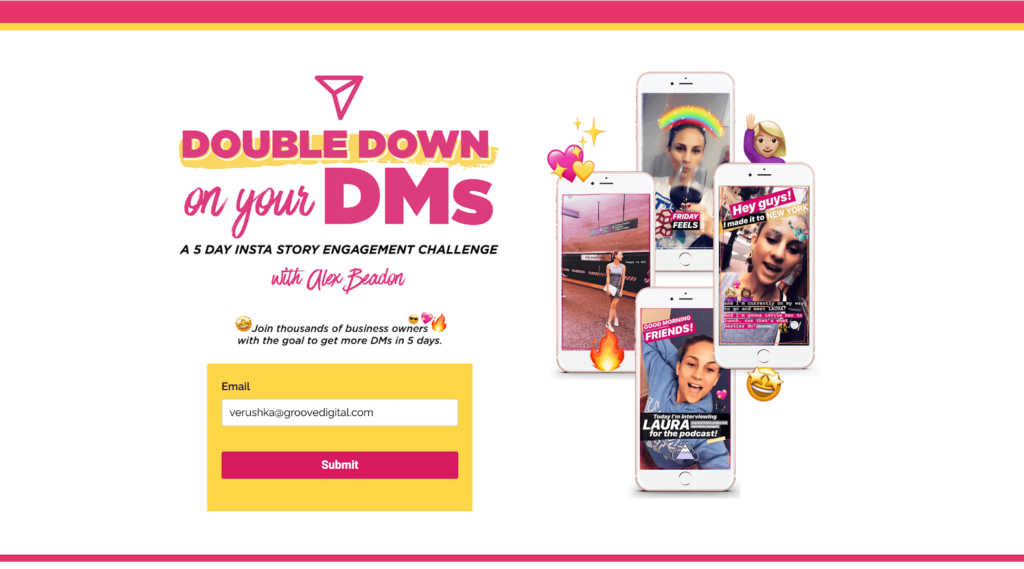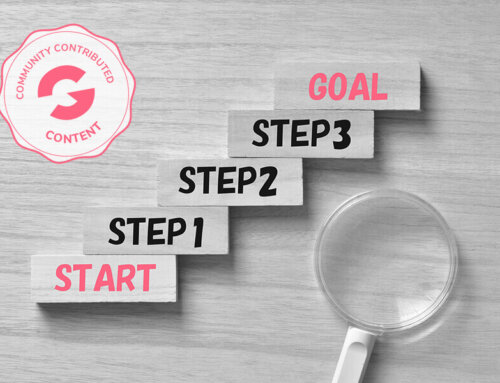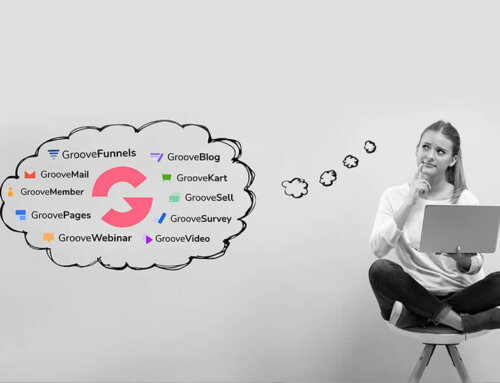If you’re relying on your social media presence and engagement to generate leads as a course creator, you’re relying on social media algorithms. And those are pesky little things that keep marketers bouncing around, trying to figure out and keep track of all the latest trends when it comes to growing your online audience. It’s a love-hate relationship.
As a small business owner, a classic solopreneur, trying to grab and hold attention on social media can lead you down a rabbithole of non-revenue generating activities that will easily suck up your time. In exchange for, most of the time, a couple of likes and followers. Not exactly efficient, one would say.
That’s time that could be way better spent growing your email list, especially if you’re a course creator or coach. With the rise and fall of social media platforms, coupled with the ever-changing algorithm and policies, you’re better off building something that will long outlive any social networking site.
This is something that you may or may not have already heard before. It makes sense, right? But how? How exactly do you take your social media following off of social media?
By building an email list.
Done correctly, an email list can become the beating heart of your business. And, frankly, it probably should. If you don’t have a way to connect with your audience outside of your social media ecosystem, you’ve got a problem.
And not to mention, you’re almost certainly throwing away additional income too.
That’s right, they say the money is in the list… because it’s certainly not in the vanity metrics. Social media is notoriously finicky and fickle.
Now that’s not to completely bash social media marketing. Of course, there’s a perfectly logical and reasonable argument to be made for using social media for a vast array of business activities and marketing efforts. People practically live on social media, and you want to be where your potential customers are.
This isn’t necessarily an argument for one over the other, both can be used in conjunction to ultimately grow your email list. Just make sure you are actually getting prospects into your sales pipeline, either way.
The Content Marketing Institute reports that 87% of B2B marketers say that email is their top free organic distribution channel. That’s a pretty impressive majority. But building a strong and healthy email list is not an overnight endeavour.
It can, however, be greatly accelerated by a strong strategy that converts. In the case of building your list, that means successfully acquiring and capturing an email address, voluntarily, through an opt-in form on a squeeze page.
How to Grow Your List Quickly and Effectively
Host a free 5-day challenge. Perhaps you’ve seen others do this, as it’s a method that’s gained widespread popularity by business strategists like Kelly Roach and coaches alike.
Before stopping yourself dead in your tracks and wondering “But what challenge?”, put the content aside for now and focus instead on the concept itself. It’s likely that you already have go-to content that you can repurpose for this.
Thing is, people love a good challenge. Especially ones with minimal time commitment!
Anything that gets people to improve something, anything, in the least amount of time. And free participation? You’ve got the start of a killer lead magnet, basically.
In terms of conversion (successfully acquiring email addresses), there’s a self-reported 50-60% success rate for a 5-day challenge. This would naturally depend on multiple factors, including the traffic source, marketing efforts, and the landing page itself.
But the reason for the high conversion rate is simply because a 5-Day Challenge is an easy concept for people to grasp and it has a perceived immediate benefit. This isn’t an abstract possibility in the far-distant future and it isn’t going to require 2 hours sitting on a webinar each day.
If someone wants to boost their productivity, or achieve the goals they have been dreaming about, or want to get into a new routine, then signing up for a free challenge that will guide them to guaranteed success is a relatively simple decision.

Steps for Designing Your Own 5-Day Challenge
These are the building blocks to grow your list quickly and effectively by hosting a free 5-day challenge, and get prospects into your sales pipeline.
Step 1: Decide on the result.
At the end of the 5 days, what will the tangible result be? It’s important to be as specific as possible here, and avoid nonsensical filler words. When your prospect reads the challenge, they need to be sold on the final outcome of participating. It cannot be something drastic, as it is only 5 days. Rather pick something that is realistically achievable and distinctly noticeable – you want them to be victorious in the end.
Example: All participants will know how to create a high-converting slide deck for their respective webinar presentations by the end of the challenge.
Step 2: Describe who this is for.
This is your avatar of sorts. Think exactly about the person you are pitching this challenge to. Is it the corporate professional who is struggling to make progress in their career? Or the busy parent who wants to get more done at home and at work? You cannot catch everybody or else you’ll end up catching nobody. Get specific!
Example: This challenge is for single moms who are selling MLM products.
Step 3: Determine if the duration is appropriate.
We suggest customizing the challenge to purposefully fit into a 5-day challenge, but perhaps you find that a 30-day challenge is better suited for your content or outcomes. But 5 days is generally the best, at least for the initial challenge, because it’s not too long that people start to drop off and it’s not too short to take action and see some sort of result.
Example: There are enough talking points to cover at least 4 hours of training and walkthroughs on how to create a webinar slide deck, which is also enough time for beginners to master the activity.
Step 4: Choose the method of delivery.
The best is to send them the challenge via email daily. All you will need to do is sign up for a mail software (there are several options with various price points such as GrooveMail, MailChimp, MailerLite, Kajabi, and SendGrid). You could also throw in a Facebook community group, to have everyone in one space and able to communicate with one another.
Example: The participants will receive a welcome email immediately after sign up, with a link to the private Facebook group where the challenge will be hosted LIVE. They will receive daily reminders and recap emails throughout the challenge.
Step 5: Create a landing page.
It must have an opt-in form and a thank-you page. Take a look at the training over on Groove’s YouTube channel for live build demonstrations on how to do this. This is going to take some effort and a lot of time if you’d like to do it all on your own, but you could instead customize a ready-made template from the Groove template library – in which case, this will easily be done at lightning speed!
Example: The landing page will be a simple design with a clear CTA, with five bullet points that explicitly state the benefits of joining the challenge.
Step 6: Design the PDF materials and the daily social media posts.
You can create all of this by yourself with a free Canva account. The daily materials should be a short read and easy to complete. You should also add in a daily video (stick to less than 2 minutes) and any other relevant material or further resources.
Example: The daily reminder emails will have a one-page PDF with additional resources and a 10-minute homework activity.
Step 7: Promote your challenge.
Once you’ve got everything together, it’s time to start telling people about it! You can start by promoting organically across your social media channels and you could also do paid ads to reach your target audience.
Example: The challenge will be posted in 3-5 Facebook groups that target female entrepreneurs and single mothers, as well as across all social media accounts.
The additional benefits of a Facebook group is that you are able to go LIVE directly in the group and the community can ask questions.
As for your emails, you want to plan and write out all your email sequences well before the challenge begins. This includes your follow up emails to present your offer… which leads to the final thing to consider:
Now what?
You’ve captured email addresses, built your email list, and generated warm leads… but what’s the end goal? When designing your 5-day challenge and setting up your email sequences, you need a rock solid plan to keep those prospects engaged and how you’re going to sell them your offerings in future. It’s all part of having a profitable marketing funnel.
***
5-day challenges make for fantastic lead magnets that will inspire, educate, and motivate your tribe to make small changes that will have long-lasting effects in any given area. You can use this formula to generate new leads, build your email list, boost engagement, and sell your offerings.
Plus, this is content that you can easily repurpose for evergreen content. You can put the link on your website and then drive traffic year-round to sign up for the challenge. There are pros and cons to live vs evergreen, but if you launch a live challenge then you’re able to interact and engage daily with your audience – and get to know the people you will be emailing.






Leave A Comment